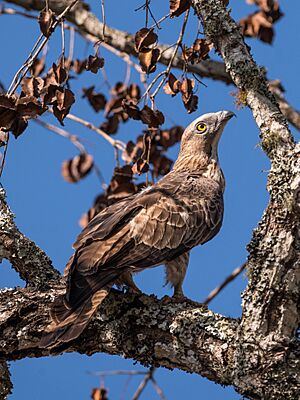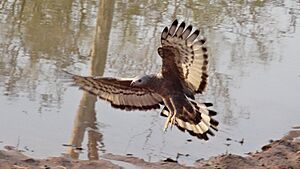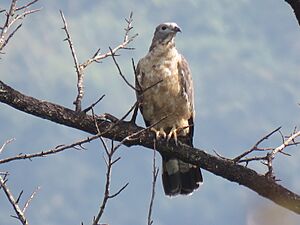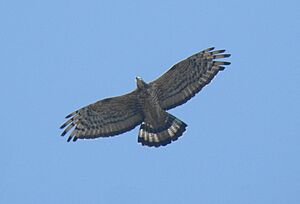Crested honey buzzard facts for kids
Quick facts for kids Crested honey buzzard |
|
|---|---|
 |
|
| Female in Mudumalai, India | |
| Conservation status | |
| Scientific classification | |
| Genus: |
Pernis
|
| Species: |
ptilorhynchus
|

The crested honey buzzard (Pernis ptilorhynchus) is a cool bird of prey. It belongs to the Accipitridae family. This family also includes other daytime hunters like kites and eagles.
These birds are also called the Oriental, Asiatic, or Eastern honey buzzard. They get their name from their favorite food. They mostly eat the larvae (baby insects) of bees and wasps. They also enjoy honey from their combs!
Crested honey buzzards are medium-sized raptors. They are about 57 to 60 centimeters (22-24 inches) long. Unlike many raptors, you can tell the males and females apart.
Some of these buzzards travel long distances. They fly to Siberia and Japan for the summer to breed. Then, they spend winter in Southeast Asia and India. Other buzzards live in these warmer areas all year. They like living in forests with open spaces. You can find them from sea level up to 1,800 meters (5,900 feet) high.
Contents
What Makes Them Special?
The crested honey buzzard has special body parts to help it find food. Its head is long, which helps it dig up underground nests. Its tongue has a special groove for eating honey.
They also have thick, short feathers on their head and neck. These feathers protect them from wasp stings. Young honey buzzards might even look like other strong eagles. This helps keep them safe from bigger predators.
Where Do They Live?
The crested honey buzzard travels a lot. They are summer visitors to Siberia and Japan. They spend their winters in warm places like Southeast Asia and India. They leave Siberia in late August and come back in May.
Some buzzards fly over the East China Sea. This is a long, non-stop flight of about 700 kilometers (435 miles). They can do this because the winds help them fly.
These birds love forests. They like lowland and hilly areas with open clearings. In some parts of Asia, you can even find them in small groups of trees near villages. They usually live from sea level up to 1,500 meters (4,900 feet). Sometimes, they go even higher, up to 1,800 meters (5,900 feet). During their long migrations, they can fly above 3,000 meters (9,800 feet)!
How They Live
What They Eat
The crested honey buzzard is a picky eater! Their main food is the larvae of social bees and wasps. They also eat parts of the honeycomb and honey itself. Sometimes, they snack on other insects like cicadas. Like other raptors, they might also eat small birds, reptiles, or frogs.
Family Life
These buzzards build their nests in woodlands. They are usually quiet, except in spring. That's when they do their mating display. They clap their wings and fly in a special "roller coaster" pattern. This is a common display for Pernis birds.
In Siberia and Japan, they breed from June to September. In India, it's from April to June. In South India, it can start as early as February.
Their nest is a platform made of sticks. It's about 40 to 80 centimeters (16-31 inches) wide. They line it with leaves. Nests are usually high up in trees. In India, they might build nests in banyan or mango trees.
The female usually lays two eggs. The eggs can be different colors, from pale cream to chestnut brown. The parents take turns sitting on the eggs for 4 to 5 weeks. The chicks learn to fly in 5 to 6 weeks. They become fully independent after about 58 weeks. Both parents help raise the young.
Special Ways They Eat
Crested honey buzzards are amazing at finding food. They dig up underground wasp nests with their strong talons. Their short toes and long second talon help them do this. Their long, thin beak with a hooked tip is also perfect for digging in nests. Their eyes are set far back, which helps them see while digging.
In South Asia, they attack wasp nests in trees. When they hunt, wasps try to sting them. But the buzzards have special feathers!
Scientists studied their head and neck feathers. They compared them to other raptors that don't eat wasps. They found that honey buzzards have a thick mat of short, stiff feathers. These feathers are close together. They act like armor, protecting the bird from stings. Other birds have longer, softer feathers that leave more skin exposed.
Some scientists even think these birds might have a special chemical on their feathers. This substance might make wasps less active. More research is needed to confirm this idea.
Staying Safe
The IUCN says the crested honey buzzard is a "least concern" species. This means they are not currently in danger of disappearing. There are probably between 100,000 and 1,000,000 of them.
However, climate change could affect them. Changing winds might make their long migrations harder. Scientists are studying how this could impact their flight paths.
On the bright side, these birds are adapting to new places. They have started living in tree plantations in Pakistan. They are also now seen in the Middle East. This shows they can find new homes.
Sadly, some people illegally sell raptors as pets. In Indonesia, some crested honey buzzards are sold online. But they are not as popular for this as some other raptors.
In Culture
In Java, Indonesia, people sometimes get stung by giant honey bees. These bees can be very aggressive. Local people blame the honey buzzards for these attacks. They believe that when a buzzard takes honey, angry bees chase it. They think the buzzard then flies near humans to make the bees attack the people instead.
However, scientists have studied the buzzards for many years. They have not seen any evidence of this behavior. It's more likely that human activities are reducing the bees' natural homes. This might cause more conflict between bees and people.
Images for kids






